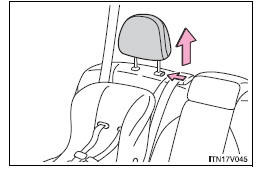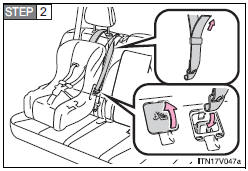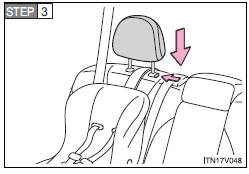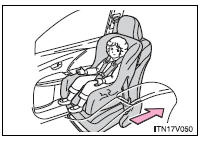Toyota Venza: Child restraint systems with a top tether strap
 Secure the child restraint using
Secure the child restraint using
a seat belt or lower anchors, and do the following.
► Outside

Adjust the head restraint to the upmost position.
► Center

Lower the head restraint to the lowest position.

Open the anchor bracket cover, latch the hook onto the anchor bracket and tighten the top tether strap.
Make sure the top tether strap is securely latched.

Outside only: Adjust the head restraint to the downmost position.
- Laws and regulations pertaining to anchors
The LATCH system conforms to FMVSS225 or CMVSS210.2.
Child restraint systems conforming to FMVSS213 or CMVSS213 specifications can be used.
This vehicle is designed to conform to the SAE J1819.
CAUTION
- When installing a booster seat
Do not fully extend the shoulder belt to prevent the belt from going to ALR lock mode: ALR mode causes the belt to tighten only which could cause injury or discomfort to the child.
CAUTION
- When installing a child restraint system
Follow the directions given in the child restraint system installation manual and fix the child restraint system securely in place.
If the child restraint system is not correctly fixed in place, the child or other passengers may be seriously injured or even killed in the event of sudden braking, sudden swerving or an accident.

• If the driver’s seat interferes with the child restraint system and prevents it from being attached correctly, attach the child restraint system to the righthand rear seat.
• Adjust the front passenger seat so that it does not interfere with the child restraint system.

• Only put a forward-facing child restraint system on the front seat when unavoidable.
When installing a forward-facing child restraint system on the front passenger seat, move the seat as far back as possible even if the “AIR BAG OFF” indicator light is illuminated. Failing to do so may result in death or serious injury if the airbags deploy (inflate).
CAUTION
- When installing a child restraint system
• When installing a child restraint system in the rear center seat, adjust both seatbacks at the same angle. Otherwise, the child restraint system cannot be securely restrained and this may cause death or serious injuries in the event of sudden braking, sudden swerving or an accident.
• When using the LATCH anchors for a child restraint system, adjust the seatback as upright as possible.
• When a booster seat is installed, always ensure that the shoulder belt is positioned across the center of the child’s shoulder. The belt should be kept away from the child’s neck, but not so that it could fall off the child’s shoulder. Failing to do so may result in death or serious injury in the event of sudden braking, sudden swerving or an accident.
• Ensure that the belt and tab are securely locked and the seat belt is not twisted.
• Shake the child restraint system left and right, and forward and backward to ensure that it has been securely installed.
• After securing a child restraint system, never adjust the seat.
• Follow all installation instructions provided by the child restraint system manufacturer.
CAUTION
- Do not use a seat belt extender
If a seat belt extender is used when installing a child restraint system, the seat belt will not securely hold the child restraint system, which could cause death or serious injury to the child or other passengers in the event of sudden braking, sudden swerving or an accident.
- To correctly attach a child restraint system to the anchors
When using the LATCH anchors, be sure that there are no foreign objects around the anchors and that the seat belt is not caught behind the child restraint. Make sure the child restraint system is securely attached, or it may cause death or serious injury to the child or other passengers in the event of a sudden stop, sudden swerve or an accident.
 Removing a child restraint installed with a seat belt
Removing a child restraint installed with a seat belt
Press the buckle release button and fully retract the seat belt. ...
 When driving
When driving
Driving, stopping and safe-driving information ...
Other materials about Toyota Venza:
Installation
INSTALLATION
PROCEDURE
1. INSTALL REAR DOOR UPPER WINDOW FRAME MOULDING
(a) Engage the guide and install the rear door upper window frame moulding
to the door frame.
(b) Using an air riveter or ...
Disassembly
DISASSEMBLY
PROCEDURE
1. REMOVE COOLER DRYER
(a) Using a 14 mm straight hexagon wrench, remove the cap from the modulator.
Text in Illustration
*1
14 mm Straight Hexagon Wrench
*2 ...
Horn Circuit
DESCRIPTION
When the theft deterrent system is switched from the armed state to the alarm
sounding state, the main body ECU (driver side junction block assembly) transmits
a signal to cause the horn to sound at intervals of 0.4 seconds.
WIRING DIAGRAM
...
0.1415
